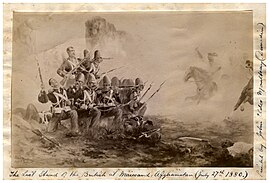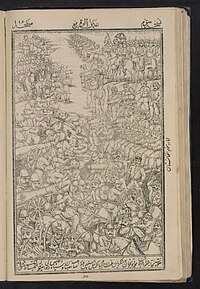Battle of Maiwand
| Battle of Maiwand | |||||||
|---|---|---|---|---|---|---|---|
| Part of Second Anglo-Afghan War | |||||||
 "Maiwand: Saving the Guns". Royal Horse Artillery withdrawing from Afghan attack at the Battle of Maiwand, painted by Richard Caton Woodville | |||||||
| |||||||
| Belligerents | |||||||
|
| |||||||
| Commanders and leaders | |||||||
|
|
Ayub Khan | ||||||
| Strength | |||||||
| 2,476 British/Indian troops |
25,000 warriors | ||||||
| Casualties and losses | |||||||
| 1,200 killed[1] | Unknown, estimates from 2,000—5,000[2] | ||||||
The Battle of Maiwand (
Prelude
Before the battle, the campaign had gone well for the British. They had defeated Afghan tribesmen at Ali Masjid, Peiwar Kotal, Kabul, and the Battle of Ahmed Khel, and they had occupied numerous cities and towns, including Kandahar, Dakka, and Jalalabad.

The battle (27 July 1880)


On the afternoon of 26 July information was received that the Afghan force was making for the Maiwand Pass a few miles away (half-dozen km). Burrows decided to move early the following day to break-up the Afghan advance guard. At about 10 am horsemen were seen and engaged, and the brigade started to deploy for battle. Burrows was not aware that it was Ayub's main force. The Afghans numbered 25,000 including Afghan regular troops and five batteries of artillery, including some very modern Armstrong guns. The Afghan guns gradually came into action and a three-hour artillery duel ensued at an opening range of about 1,700 yards (1,600 m), during which the British captured smoothbore guns on the left expended their ammunition and withdrew to replenish it. This enabled the Afghans to force the left battalion back. The left flank comprising Indian infantry regiments gave way and rolled in a great wave to the right; the 66th Regiment, as a result of this pressure was swept away by the pressure of the Ghazi attack.[4][page needed]
E Battery of B Brigade

E Battery came into action again some 400 yd back (370 m). The Sappers and Miners retreated as the guns withdrew. Henn and 14 of his men afterwards joined some remnants of the 66th Foot and Bombay Grenadiers in a small enclosure at a garden in a place called Khig where a determined last stand was made. Though the Afghans shot them down one by one, they fired steadily until only eleven of their number (two officers and nine other ranks)[5] were left, and the survivors then charged out into the masses of the enemy and perished. Henn is the only officer who has been positively identified in that band and he led the final charge.[6] No Englishman lived to tell the story of the Last Eleven at Maiwand. It was reported to the British later that year by a former officer of Ayub Khan's army, who said that the Afghans had been truly impressed by the bravery of those men.[5]
The retreat to Kandahar (27–28 July 1880)
Word of the disaster reached Kandahar the following day and a relief force was dispatched. This met the retreating force at Kokeran.
The British were routed, but managed a withdrawal due to their own efforts and the apathy of the Afghans. Of the 2,476 British troops engaged, the British and Indian force lost 1,200 men. The Grenadiers lost 64% of their strength and the 66th lost 62%, including twelve officers, of those present (two companies being detached); the cavalry losses were much smaller. British and Indian regimental casualties (listed by brigade) were:[citation needed]
- 1st Infantry Brigade (Brigadier-General George Burrows, commanding)
- 66th (Berkshire) Regiment of Foot: 286 dead, 32 wounded.
- 1st Bombay Native Infantry (Grenadiers): 366 dead 61 wounded.
- 30th Bombay Native Infantry (Jacob’s Rifles): 241 dead, 32 wounded.
- Bombay Sappers and Miners(No.2 Company): 16 dead, 6 wounded.
- 1st Cavalry Brigade (Brigadier-General Thomas Nuttall, commanding)
- E Battery / B Brigade, Royal Horse Artillery:[7] 19 dead, 16 wounded.[4]
- 3rd Bombay Light Cavalry: 27 dead, 18 wounded.
- 3rd Scinde Horse: 15 dead, 1 wounded.
One estimate of Afghan casualties is 3,000, reflecting the desperate nature of much of the fighting,[3] although other sources give 1,500 Afghan "regulars" and up to 4,000 Ghazis killed, and 1500 seriously wounded.[8]
Awards for bravery
Two
Aftermath

The battle dampened morale for the British side, but was also partly a disappointment for
The loss of the
Maiwand in poetry, art, and fiction
Poetry
Rudyard Kipling, who had researched this battle in 1892, included the small yet dramatic poem entitled "That Day" about the action at Maiwand in his Barrack-Room Ballads collection:
- "There was thirty dead an' wounded on the ground we wouldn't keep -
- No, there wasn't more than twenty when the front began to go;
- But, Christ! along the line o' flight they cut us up like sheep,
- An' that was all we gained by doing so.
- I 'eard the knives be'ind me, but I dursn't face my man,
- Nor I don't know where I went to, 'cause I didn't 'alt to see,
- Till I 'eard a beggar squealin' out for quarter as 'e ran,
- An' I thought I knew the voice an' - it was me!
- We was 'idin' under bedsteads more than 'arf a march away;
- We was lyin' up like rabbits all about the countryside;
- An' the major cursed 'is Maker 'cause 'e lived to see that day'
- An' the colonel broke 'is sword acrost, an' cried."
The events of the battle were also commemorated in a poem by Scottish poet William McGonagall entitled "The Last Berkshire Eleven".[9]
Poems of the victory at Maiwand have passed into
- Young love if you do not fall in the battle of Maiwind;
- By God someone is saving you as a token of shame;
She also spoke the following landay (Pashto Poetry):
- With a drop of my sweetheart's blood,
- Shed in defense of the Motherland,
- Will I put a beauty spot on my forehead,
- Such as would put to shame the rose in the garden.[citation needed]
Art

The battle was the subject of several paintings[10] and was covered extensively in the illustrated press. Frank Feller, a Swiss artist domiciled in England painted The Last Eleven at Maiwand in 1882 depicting a small group of men from the 66th Regiment making a last stand. The events surrounding E/B Battery Royal Horse Artillery were portrayed by Godfrey Douglas Giles, Richard Caton Woodville and Stanley Wood.
A cast iron statue of a lion (the Maiwand Lion) was built by George Blackall Simonds in Reading and unveiled in 1886 to commemorate those who died in battle. A monument was built in the 1950s on the Maiwand Square in Kabul in commemoration of the battle by an Afghan architect Is-matulla Saraj.
A memorial was erected in central London to a remarkable canine survivor of the engagement: Bobbie, the Berkshires' regimental mascot. Bobbie was wounded during the fighting, but was spotted the following day by survivors, making his way back to the fort.
Fiction
The fictional
The Battle of Maiwand is also mentioned in Jeffery Deaver's short story The Westphalian Ring. The main character, Peter Goodcastle, had served in the Royal Horse Artillery there and had turned to burglary to avenge the shoddy treatment he had suffered on his return to Britain. In the short story, he was arrested by none other than Dr. Watson, but later managed to escape suspicion by outsmarting Sherlock Holmes, so the two men may have already met earlier.
British author Tim Symonds refers in detail to Watson's life-changing Maiwand experience in his novel 'Sherlock Holmes And The Strange Death of Brigadier-General Delves' (MX Publishing 2022)
See also
- Battles of the Second Anglo-Afghan War
- Bobbie
- The Great Game– 19th-century Anglo-Russian confrontation
References
Citations
- ISBN 9781789140101.
- ^ Robson 2007, p. 239.
- ^ a b "Battle of Maiwand". britishbattles.com. Retrieved 6 November 2017.
- ^ a b c Headlam 1931.
- ^ a b Stacpoole-Ryding & Chaloner 2008.
- ^ Sandes 1948, pp. 278–281.
- ^ "145 (Maiwand) Commando Battery" (PDF). Archived from the original (PDF) on 8 March 2012. Retrieved 17 April 2011.
- ^ Gore, David. "My god - Maiwand". The British Empire, Imperialism, Colonialism, Colonies. Retrieved 6 November 2017.
- ^ "The Last Berkshire Eleven". McGonagall Online. Retrieved 6 November 2017.
- ^ Harrington 1993, pp. 202–204.
- ^ "The Rifles (Berkshire and Wiltshire) Museum". Archived from the original on 12 October 2007.
- ^ Groves 1887.
Sources
- Groves, J. Percy (1887). The 66th Berkshire Regiment. London: Joseph J. Beecroft.
- Harrington, Peter (1993). British Artists and War: The Face of Battle in Paintings and Prints 1700-1914. London: Greenhill Books/Lionel Leventhal. ISBN 978-1-85367-157-9.
- Headlam, Major General Sir John (1931). The History of the Royal Regiment of Artillery - From the Indian Mutiny to the Great War Volume III-Campaigns (1860-1914). Woolwich: Royal Artillery Institution. p. 44.
- Robson, Brian (2007). The Road to Kabul: The Second Afghan War, 1878-1881. Stroud: Spellmount. ISBN 978-1-86227-416-7.
- Sandes, E. W. C. (1948). The Indian Sappers and Miners. Chatham: Institution of Royal Engineers.
- Stacpoole-Ryding, Richard J.; Chaloner, Andy (2008). Maiwand: The Last Stand of the 66th (Berkshire) Regiment in Afghanistan, 1880. History Press. ISBN 978-0-7524-4537-3.
